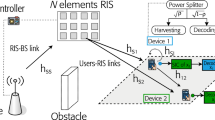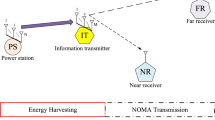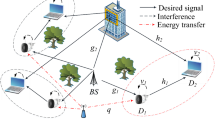Abstract
Nonorthogonal multiple access (NOMA) is used to superpose multifarious user signals for concurrent transmission, enhancing spectral efficiency. Additionally, wireless energy sources neighbouring the NOMA sender are utilized for enhanced energy efficiency. Practically, nonlinear energy harvesting (nlEH) circuits reflect faithfully characteristics of components implementing these circuits. In addition, reflected intelligent surface (RIS) is helpful with a role of the relay to maintain communication from the NOMA sender to the far NOMA recipient. However, challenges in RIS-aided NOMA with nlEH (RISaNOMAwEH) include channel state error (CSE) and fading severity. These factors directly impact harvested energy and communication reliability. As such, this paper analyzes their influences on the RISaNOMAwEH through three pivotal metrics (total throughput, outage probability, energy efficiency) under practical considerations like the nlEH, the CSE, and relatively-general fading (Nakagami-m). Demonstrative results reveal that the CSE, the fading severity m, and the quantity of the reflectors of the RIS drastically impact these metrics whereas the nlEH slightly influences them. Remarkably, the RISaNOMAwEH can conduct the prevention of complete outage through proper adoption of required spectral efficiency (R), time splitting factor \((\eta )\), and power splitting coefficient. Moreover, optimum metrics are achieved with the optimal configuration of parameters \((R, \eta )\). Furthermore, the proposed scheme dramatically outperforms a benchmark scheme (RIS-aided orthogonal multiple access (OMA) with nlEH) in various parameter configurations, highlighting the benefits of NOMA over OMA.









Similar content being viewed by others
Data Availability
All data used to support the findings of this study are included within the article.
Notes
The paper adopts the NOMA for each group of two terminals, a choice motivated by previous studies indicating that accreting the number of terminals in each cluster can be intricate and inefficacious [36, 37]. Also, the 3GPP-LTE-A has already encompassed two-terminal NOMA [38, 39]. Notwithstanding, the paper does not delve into the specifics of how to cluster these two terminals, acknowledging that this aspect falls outside the scope of the paper. Interested researchers are directed to consult other references (e.g. [4, 40,41,42,43]) for a more comprehensive understanding of this topic.
SINR indicates signal to interference plus noise ratio.
This research investigates the context in which the NT conducts the recovery of \(x_n\) merely if it has exactly decoded \(x_f\). The specific condition for verifying whether the NT has successfully restored \(x_f\) is going to be presented. As a consequence of the exact recovery of \(x_f\), the interference that was present in the NT’s received signal after suppressing \(x_f\) will be no longer available.
SNR indicates signal to noise ratio.
Total throughput is the throughput of the NT plus that of the FT.
References
Boudjit, S., Abdennebi, M., Manirabona, A., & Zangar, N. (2023). End-to-End 5G priority scheduling strategy for a WBAN health monitoring system. In Proceedings of IEEE WiMob, Montreal, QC, Canada, pp. 116–122.
Psaromanolakis, N., Theodorou, V., Laskaratos, D., Kalogeropoulos, I., Vlontzou, M. E., Zarogianni, E., & Samaras, G. (2023). MLOps meets edge computing: An edge platform with embedded intelligence towards 6G Systems. In: Proceedings of IEEE EuCNC/6G Summit, Gothenburg, Sweden, pp. 496–501.
Le-Thanh, T., et al. NOMA MIMO communications with harvested energy: performance evaluation. ETRI Journal To be published.
Li, J., Chen, H. H., & Guo, Q. (2022) On the performance of NOMA systems with different user grouping strategies. IEEE Wireless Communication.
Fan, Z., Li, Y., Wan, Q., Yang, S., Tao, X., & Gao, Y. (2023). A highly efficient auto-polarity energy harvesting circuit based on reconfigurable TEG array for wearable applications. In: Proceedings of IEEE ISCAS, Monterey, pp. 1–4.
Lian, W. X., Ramiah, H., Chong, G., Churchill, K. K. P., Lai, N. S., & Mekhilef, S. (2023). A Fully-Integrated CMOS Dual-Band RF energy harvesting front-end employing adaptive frequency selection. IEEE Access, 11, 74121–74135.
Dang-Ngoc, H., et al. (2022). Secure swarm UAV-assisted communications with cooperative friendly jamming. IEEE IoT Journal, 9(24), 25596–25611.
Nguyen, V. S. (2023). Performance analysis of cognitive-inspired wireless powered NOMA systems with joint collaboration. IEEE Access, 11, 51578–51589.
Xu, Y., Xu, R., Li, D., Yang, G., Wang, G., Yuen, C., & Zhou, J. (2023). Robust resource allocation for wireless-powered backscatter communication systems with NOMA. IEEE Transactions on Vehicular Technology, 72(9), 12288–12299.
Zhang, J., Zhang, L., & Pan, G. (2023). Outage performance for NOMA-based FSO-RF systems with a dual energy harvesting mode. IEEE IoT Journal, 10(18), 16076–16086.
Wang, D., Rezaei, F., & Tellambura, C (2020). Performance analysis and resource allocations for a WPCN with a new nonlinear energy harvester model. IEEE OJCOMS, 1, 1403–1424.
Agrawal, K., Jee, A., Makhanpuri, U., & Prakriya, S. (2023). Performance of full-duplex cooperative NOMA with mode switching and an EH near user. IEEE Networking Letters, 5(4), 284–288.
Solanki, S., Upadhyay, P. K., Da Costa, D. B., Ding, H., & Moualeu, J. M. (2020). Performance analysis of piece-wise linear model of energy harvesting-based multiuser overlay spectrum sharing networks. IEEE OJCS, 1, 1820–1836.
Le-Thanh, T., & Ho-Van, K. (2023). Jamming-and-relaying strategy for non-linear energy scavenging networks. Arabian Journal for Science and Engineering, 48, 14621–14638.
Singh, S. K., Agrawal, K., Singh, K., Li, C. P., & Alouini, M. S. (2022). NOMA enhanced UAV-assisted communication system with nonlinear energy harvesting. IEEE OJCS, 3, 936–957.
Wang, D., & Men, S. (2018). Secure energy efficiency for NOMA based cognitive radio networks with nonlinear energy harvesting. IEEE Access, 6, 62707–62716.
Parihar, A. S., Swami, P., Choi, K., Brida, P., & Bhatia, V. (2023). On performance of NOMA-based wireless powered communication networks assisted with power beacons and PPP distributed IN. IEEE Wireless Communications Letters, 12(7), 1294–1298.
Yang, Y., Gong, Y., & Wu, Y. C. (2023) Energy Sensitive Binary Offloading for reconfigurable-intelligent-surface-assisted wireless powered mobile edge computing. IEEE IoT Journal To be published.
Ahmed, F., Hassan, T., Melouki, N., Naseri, H., PourMohammadi, P., Iqbal, A., & Denidni, T. A. (2024). A multibit and frequency-reconfigurable reflecting surface for RIS applications. IEEE Antennas and Wireless Propagation Letters, 23(2), 653–657.
Zhao, M. M., Wu, Q., Zhao, M. J., & Zhang, R. (2021). Intelligent reflecting surface enhanced wireless network: Two-timescale beamforming optimization. IEEE Transactions on Wireless Communications, 20(1), 2–17.
Ennajih, A., Sardi, A., Sadik, M., & Zbitou, J. (2023). Design and analysis of intelligent reflecting surface for 5G applications. In: Proceedings of IEEE WINCOM, Istanbul, Turkiye, pp. 1–5.
Dang-Ngoc, H., Ho-Van, K., & Do-Dac, T. (2021). Secrecy analysis of overlay mechanism in radio frequency energy harvesting networks with Jamming under Nakagami-m fading. Wireless Personal Communications, 120, 447–479.
Do-Dac, T., & Ho-Van, K. (2020). Spectrum sharing paradigm under primary interference and Nakagami-\(m\) fading: Security analysis. Wireless Personal Communications, 111, 1607–1623.
Do-Dac, T., & Ho-Van, K. (2021). Energy harvesting cognitive radio networks: Security analysis for Nakagami-\(m\) Fading. Wireless Network, 27, 1561–1572.
Ho-Van, K., et al. (2019). Security analysis for underlay cognitive network with energy scavenging capable relay over Nakagami-\(m\) fading channels. Wireless Communication Mobile Computer, 2019, 1–16.
Ashraf, U., & Begh, G. R. (2021). Performance evaluation of Nakagami-\(m\) fading with impulsive noise. IET Communications, 15, 364–373.
Zhang, G., Gu, X., Duan, W., Wen, M., Choi, J., Gao, F., & Ho, P. H. (2023). Hybrid time-switching and power-splitting EH relaying for RIS-NOMA downlink. IEEE Transactions on Cognitive Communications and Networking, 9(1), 146–158.
Hong, S., Pan, C., Ren, H., Wang, K., Chai, K. K., & Nallanathan, A. (2021). Robust transmission design for intelligent reflecting surface-aided secure communication systems with imperfect cascaded CSI. IEEE Transactions on Wireless Communications, 20(4), 2487–2501.
Zhao, M. M., Wu, Q., Zhao, M. J., & Zhang, R. (2021). Exploiting amplitude control in intelligent reflecting surface aided wireless communication with imperfect CSI. IEEE Transactions on Communications, 69(6), 4216–4231.
Cao, G., Li, M., Yuan, H., Chen, W., Li, L., & Raouf, A. (2023). rror performance of RIS-assisted NOMA networks with imperfect channel state information. In: Proceedings of IEEE VTC2023-Spring, pp. 1–5.
Wang, T., Chen, G., Coon, J. P., & Badiu, M. A. (2020). Chernoff bounds and saddlepoint approximations for the outage probability in intelligent reflecting surface assisted communication systems. arXiv preprintarXiv:2008.05447.
Samuh, M. H., Salhab, A. M., & El-Malek, A. H. A. (2020). Performance analysis and optimization of RIS-assisted networks in Nakagami-\(m\) environment. arXiv:2010.07841.
Alanazi, F. (2021). Intelligent reflecting surfaces with energy harvesting for Nakagami fading channels. Telecommunication System, 78, 351–361.
Lei, J., et al. NOMA for STAR-RIS assisted UAV networks, IEEE Transactions on Communications To be published.
Yang, Z., Xia, L., Cui, J., Dong, Z., & Ding, Z. (2023) Delay and energy minimization for cooperative NOMA-MEC networks with SWIPT aided by RIS. IEEE Transactions on Vehicular Technology. To be published.
Ardakani, F. D., Huang, R., & Wong, V. W. (2022). Joint device pairing, reflection coefficients, and power control for NOMA backscatter systems. IEEE Transactions on Vehicular Technology, 71(4), 4396–4411.
Zhao, F., Xu, W., & Xiang, W. (2022). Integrated satellite-terrestrial networks with coordinated C-NOMA and relay transmission. IEEE Systems Journal, 16(4), 5270–5280.
Study on Downlink Multiuser Superposition Transmission for LTE. (2015). 3GPP. China: Shanghai.
Chen, G., Qiu, L., & Ren, C. ( (2020). On the performance of cluster-based MIMO NOMA in multi-cell dense networks. IEEE Transactions on Communications, 68(8), 4773–4787.
Ding, Z., Fan, P., & Poor, H. V. (2016). Impact of user pairing on 5G nonorthogonal multiple-access downlink transmissions. IEEE Transactions on Vehicular Technology, 65, 6010–6023.
Khazali, A., Tarchi, D., Shayesteh, M. G., Kalbkhani, H., & Bozorgchenani, A. (2022). Energy efficient uplink transmission in cooperative mmWave NOMA networks with wireless power transfer. IEEE Transactions on Vehicular Technology, 71(1), 391–405.
Si, Q., Jin, M., Tsiftsis, T. A., Zhao, N., & Wang, X. (2021). Cooperative SM-based NOMA scheme with SWIPT. IEEE Transactions on Vehicular Technology, 70(6), 6195–6199.
Li, X., et al. (2021). Cooperative wireless-powered NOMA relaying for B5G IoT networks with hardware impairments and channel estimation errors. IEEE IoT Journal, 8(7), 5453–5467.
Abramowitz, M., et al. (1972). Handbook of Mathematical Functions with Formulas, Graphs, and Mathematical Tables, Tenth printing ed., Washington, DC, USA: U.S. Government Printing Office
Gradshteyn, I. S., & Ryzhik, I. M. (2000). Table of integrals, series and products (6th ed.). San Diego, CA: Academic.
Jørstad, K., Meyer, L., Santos, A. Q., Mortensen, L. K., Shaker, H. R., & Handrup, K. (2023). Binary search for three-phase fault location in low voltage distribution systems using smart meters’ last gasp functionality. In: Proceedings of IEEE CPEEE, Tokyo, Japan, pp. 275–280.
Alrajoubi, H., & Oncu, S. (2023). PV Fed water pump system with golden section search and incremental conductance algorithms. In: Proceedings of IEEE ECAI, Bucharest, Romania, pp. 1–4.
Acknowledgement
We acknowledge the support of time and facilities from Ho Chi Minh City University of Technology (HCMUT), VNU-HCM, for this study.
Funding
This article is not supported by any funding
Author information
Authors and Affiliations
Corresponding author
Ethics declarations
Competing Interests
The authors have not disclosed any competing interests.
Ethical Approval
Not applicable.
Additional information
Publisher's Note
Springer Nature remains neutral with regard to jurisdictional claims in published maps and institutional affiliations.
Rights and permissions
Springer Nature or its licensor (e.g. a society or other partner) holds exclusive rights to this article under a publishing agreement with the author(s) or other rightsholder(s); author self-archiving of the accepted manuscript version of this article is solely governed by the terms of such publishing agreement and applicable law.
About this article
Cite this article
Ho-Van, K. RIS-aided NOMA with Nonlinear Energy Harvesting Under Channel State Error and Nakagami-m Fading: Performance Evaluation. Wireless Pers Commun 135, 1397–1422 (2024). https://doi.org/10.1007/s11277-024-11088-1
Accepted:
Published:
Issue Date:
DOI: https://doi.org/10.1007/s11277-024-11088-1




